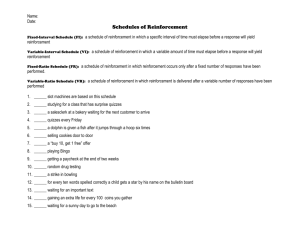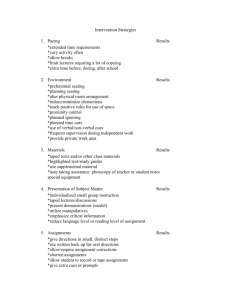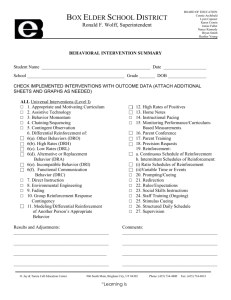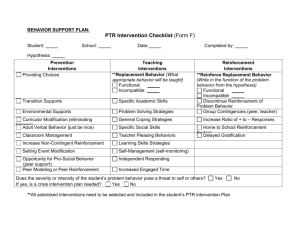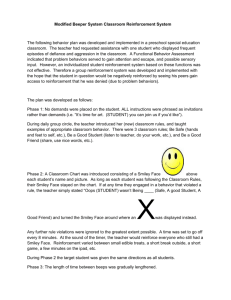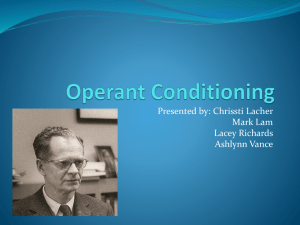Aggression-Under-FR
advertisement
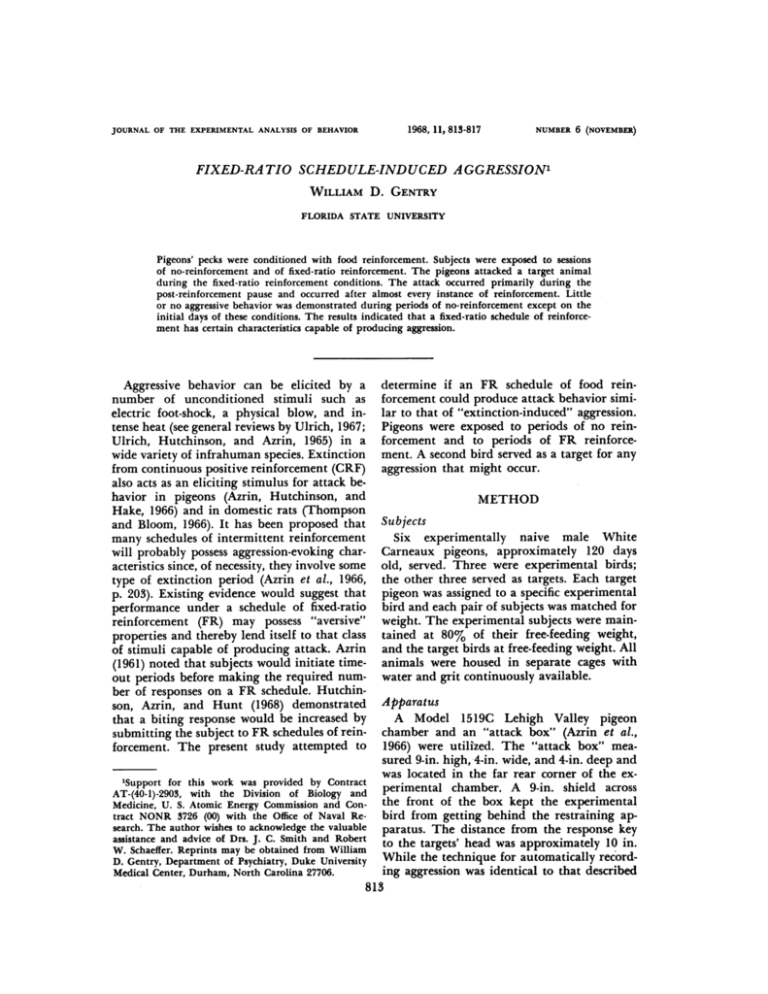
1968, 11., 813-817 JOURNAL OF THE EXPERIMENTAL ANALYSIS OF BEHAVIOR NUMBER 6 (NOVEMBER) FIXED-RA TIO SCHED ULE-IND UCED AGGRESSION' WILLIAM D. GENTRY FLORIDA STATE UNIVERSITY Pigeons' pecks were conditioned with food reinforcement. Subjects were exposed to sessions of no-reinforcement and of fixed-ratio reinforcement. The pigeons attacked a target animal during the fixed-ratio reinforcement conditions. The attack occurred primarily during the post-reinforcement pause and occurred after almost every instance of reinforcement. Little or no aggressive behavior was demonstrated during periods of no-reinforcement except on the initial days of these conditions. The results indicated that a fixed-ratio schedule of reinforcement has certain characteristics capable of producing aggression. Aggressive behavior can be elicited by a number of unconditioned stimuli such as electric foot-shock, a physical blow, and intense heat (see general reviews by Ulrich, 1967; Ulrich, Hutchinson, and Azrin, 1965) in a wide variety of infrahuman species. Extinction from continuous positive reinforcement (CRF) also acts as an eliciting stimulus for attack behavior in pigeons (Azrin, Hutchinson, and Hake, 1966) and in domestic rats (Thompson and Bloom, 1966). It has been proposed that many schedules of intermittent reinforcement will probably possess aggression-evoking characteristics since, of necessity, they involve some type of extinction period (Azrin et al., 1966, p. 203). Existing evidence would suggest that performance under a schedule of fixed-ratio reinforcement (FR) may possess "aversive" properties and thereby lend itself to that class of stimuli capable of producing attack. Azrin (1961) noted that subjects would initiate timeout periods before making the required number of responses on a FR schedule. Hutchinson, Azrin, and Hunt (1968) demonstrated that a biting response would be increased by submitting the subject to FR schedules of reinforcement. The present study attempted to 'Support for this work was provided by Contract AT-(40-1)-2903, with the Division of Biology and Medicine, U. S. Atomic Energy Commission and Contract NONR 3726 (00) with the Office of Naval Research. The author wishes to acknowledge the valuable assistance and advice of Drs. J. C. Smith and Robert W. Schaeffer. Reprints may be obtained from William D. Gentry, Department of Psychiatry, Duke University Medical Center, Durham, North Carolina 27706. determine if an FR schedule of food reinforcement could produce attack behavior similar to that of "extinction-induced" aggression. Pigeons were exposed to periods of no reinforcement and to periods of FR reinforcement. A second bird served as a target for any aggression that might occur. METHOD Subjects Six experimentally naive male White Carneaux pigeons, approximately 120 days old, served. Three were experimental birds; the other three served as targets. Each target pigeon was assigned to a specific experimental bird and each pair of subjects was matched for weight. The experimental subjects were maintained at 80% of their free-feeding weight, and the target birds at free-feeding weight. All animals were housed in separate cages with water and grit continuously available. Apparatus A Model 1519C Lehigh Valley pigeon chamber and an "attack box" (Azrin et al., 1966) were utili'zed. The "attack box" measured 9-in. high, 4-in. wide, and 4-in. deep and was located in the far rear corner of the experimental chamber. A 9-in. shield across the front of the box kept the experimental bird from getting behind the restraining apparatus. The distance from the response key to the targets' head was approximately 10 in. While the technique for automatically recording aggression was identical to that described 813 814 WILLIAM D. GENTRY by Azrin et al. (1966), the measure of attack was one of frequency rather than of duration. When a force exceeding 100 g was exerted against the target bird, housed in the restraining box, the contacts of an electrical microswitch were closed. Each closure activated a response counter and served as a unit of attack. Close visual observation revealed that spontaneous movement by the target bird was insufficient to close the circuit and register an aggressive response. Food reinforcement was made available to the experimental subject by means of a standard food-hopper located in the center of the front panel of the chamber. A standard illuminated response key was also located on this front panel. The test chamber was generally illuminated by an overhead houselight. All FR reinforcement scheduling and recording of the aggressive responses was accomplished through a system of electrical switching circuits located on a control panel in an adjacent room. A white-noise generator provided a continuous masking noise during the entire course of each experimental session. A glass panel on the door of the experimental chamber enabled the experimenter to view the birds at any time without disrupting their behavior. Procedure The procedure consisted of an ABAB design: no-reinforcement, fixed-ratio reinforcement, return to no-reinforcement, and return to FR reinforcement. Each phase consisted of five 45-min sessions, giving a total of 20 sessions for each pair of birds. The sessions were conducted daily without exception. During the initial period of no-reinforcement, each pair of birds was placed in the experimental chamber with the reinforcement mechanism inoperative. This baseline condition yielded a measure of aggressive behavior before any history of FR reinforcement. Following this, the target bird was removed from the test chamber until the experimental pigeon had been trained to eat from a food magazine and to peck a response key. This was accomplished through conventional shaping procedures. Responses were initially reinforced on a continuous reinforcement (CRF) schedule, but subjects were rapidly submitted to progressively increasing ratio requirements. Stable responding on an FR-50 response requirement was achieved for all three experi- mental birds within five days of training. The FR-50 reinforcement schedule was utilized primarily in keeping with Azrin (1961). The food magazine was presented for 10 sec after every 50 key responses. The target bird was reintroduced to the test situation and the second phase of the experiment was instituted. After five sessions of FR responding, the response key was taped over and the reinforcement mechanism again became inoperative. A final phase of fixed-ratio reinforcement followed. RESULTS Figures 1 and 2 show the frequency of aggressive responses in all four phases of the experiment for two pairs of subjects. All three pairs of pigeons followed the same pattern, the only difference being in the relative amount of attack behavior displayed. While two pairs of birds (S-1 and S-2) exhibited very noticeable amounts of aggression, the third pair (S-3, not graphed) exhibited very little. Table 1 shows the total number of attack responses for each pair of subjects during all four phases of the experiment. Visual observation revealed that the aggressive behavior exhibited in this experiment NO NO REINF. FR 501 REINE FR 50 1 I 1. zi ~~~~~~~~II SESSIONS Fig. 1. Frequency of aggressive responses made against a target pigeon by Pigeon #1 in alternated noreinforcement and FR-50 sessions. Under no-reinforcement, the reinforcement mechanism was inoperative. Under FR-50, the pigeon received food reinforcement on a FR-50 schedule. FIXED-RATIO SCHEDULE-INDUCED AGGRESSION 10 SESSIONS Fig. 2. Frequency of aggressive responses made against a target pigeon by Pigeon #2 in alternated no-reinforcement and FR-50 sessions. Under no-reinforcement, the reinforcement mechanism was inoperative. Under FR-50, the pigeon received food reinforcement on a FR-50 schedule. was identical to that described by Azrin et al. (1966) following extinction from positive reinforcement. The experimental bird attacked the target animal by pecking at its head and throat and by pulling out its feathers. The target bird rarely fought back and often made "defensive" movements, e.g., turning its head away from the attacking experimental bird. The aggression was so intense in two pairs of animals that it resulted in serious injury to the target pigeons. During the initial day of pairing in the chamber, there was usually a noticeable incidence of aggressive behavior by the experimental subject. The frequency of attack decreased rather rapidly, however, over subsequent days of no-reinforcement and was at or near zero on the final day of the baseline Table 1 The total frequency of attack responses for no-reinforcement and FR-50 conditions. Subject NoReinf. FR-50 Reinf. FR-50 1 25 555 0 1888 6280 85 345 85 0 299 4521 95 Pairs 2 3 No- 815 period. Typically, after the first day, the experimental bird would situate itself in the front section of the chamber and only occasionally orient itself in the direction of the target animal. A marked increase in the frequency of aggressive responding occurred during the second phase of the experimental procedure, i.e., the FR reinforcement schedule. The experimental bird pecked off the FR-50 response requirement, ate from the food magazine until it disappeared, and then attacked the target pigeon before returning to the response key. Attack was initiated after the very first episode of FR reinforcement and followed nearly every instance of reinforcement thereafter. The attack tended to occur almost exclusively during the post-reinforcement pause, a finding supported by Hutchinson et al. (1968) with a biting response in squirrel monkeys. An equally noticeable decrease in aggressive behavior occurred during the third condition, i.e., when the response key was taped over and the reinforcement mechanism was again rendered inoperative. On the initial day of this phase, some aggression was exhibited; but it was much less frequent than on the previous day of FR responding. Typically, the experimental bird paced back-and-forth in front of the response key, appeared very "agitated", and periodically attacked the target pigeon. The incidence of aggression was at or near zero, however, on the second day of this condition and stayed, there throughout the remainder of this phase. The experimental bird sat quietly in front of the response key and rarely oriented itself towards the target animal. The final phase of FR reinforcement yielded attack behavior similar to that of the previous FR condition. There was a return to a relatively high frequency of aggression over the five sessions. Typically, the incidence of attack on the initial day of this condition was low; but it increased thereafter. There was evidence of much more '"ritualized" aggression (Lorenz, 1964) being exhibited during the beginning of this phase, especially on the first day. For example, the experimental bird would orient itself in the direction of the target subject and make pecking movements without actually coming into physical contact with the target animal. While conceivably aggressive in nature, these responses were merely noted and WILLIAM D. GENTRY 816 not recorded. It was only a short time until the experimental bird once again resumed the more physical, overt mode of aggression. Once again, the attack behavior tended to occur during the post-reinforcement pause and occurred after almost every instance of rein- forcement. The fact that attack tended to occur during the post-reinforcement pause became even clearer when the aggression during the FR conditions was analyzed in terms of an interreinforcement distribution (Hutchinson et al., 1968). Figure 3 shows this distribution of attack responses for two pairs of subjects during both FR responding conditions. The first interval of the distribution (50-0) incorporated all aggressive responses during the post-reinforcement pause; the other five intervals represent divisions of the FR pecking requirement in blocks of 10 responses. For S-2, some 98% of the total 10,801 attack responses occurred during the post-reinforcement pause. Almost all of the remaining attacks occurred during the early part of the response sequence (0-10). For S-1, some 93% of the total 2187 attack responses occurred during the post-reinforcement pause. The pattern was the same for the third pair of birds, S-3. DISCUSSION The present results clearly supported the observations of Azrin (1961), that a fixed-ratio 12,JOW 10.632 2400- S-2 2,040 CD w CO 1200 0~ Co w48,000cc 800 - n4 137 o3L o oriq;: 10 20 A3 40 so 5olo20 30 40 so 30 0 5 I o I I .o I . I INTER-REINFORCEMENT Fig. 3. Interreinforcement distribution of attack responses. Attack responses in the first interval occurred during the post-reinforcement pause. The pecking ratio requirement was divided into five intervals. schedule of reinforcement may possess "aversive" or negative reinforcing properties, and of Azrin et al. (1966) that other intermittent schedules will act as elicitors of aggressive behavior. The high frequency of attack during the periods of FR responding greatly resembled the "extinction-induced" aggression on a CRF schedule (Azrin et al., 1966) and the biting attack associated with various FR schedules (Hutchinson et al., 1968). Very little aggressive behavior was noted for the periods where the reinforcement mechanism was inoperative. Of greatest interest, perhaps, was the fact that the elicited attack tended to occur primarily during the post-reinforcement pause. This agreed with Azrin's (1961) findings concerning timeout or withdrawal from positive reinforcement and Hutchinson et al. (1968) data on the biting attack of squirrel monkeys. Again, it would appear that there are certain characteristics of a ratio schedule which are "aversive" and are capable of generating certain classes of responses, e.g., attack. Whether this is due to the reinforcement schedule itself or to the periodic delivery and withdrawal of food is not yet clear. Nevertheless, the combined results suggest that the nature of an organism's response to extinction or to particular scheduling effects depends in part on the availability of certain responses and on the presence of a second animal. Thus, a subject may peck a timeout key, bite a rubber tube, or attack a second organism after reinforcement on an FR schedule depending on what is available in its immediate environment. The aggression that did occur in the present study appeared to be "reflexive" in that it was under no apparent reinforcement contingencies. As Azrin (1961) suggested, the length of time between the attack behavior and the food reinforcement would seem to preclude any accidental or superstitious reinforcement of aggression. Also, since the phenomenon occurred after the initial episode of reinforcement on the first day of FR responding, it is unlikely that a learning history is involved here. The present findings have been interpreted as the result of the aggression-evoking properties of a fixed-ratio schedule of reinforcement. This phenomenon has now been demonstrated for pigeons and for primates (Hutchinson et FIXED-RATIO SCHEDULE-INDUCED AGGRESSION al., 1968). Additional evidence with other intermittent schedules and other species of animals is needed to evaluate the generality of this finding. REFERENCES Azrin, N. H. Time-out from positive reinforcement. Science, 1961, 133, 382-383. Azrin, N. H., Hutchinson, R. R., and Hake, D. F. Extinction-induced aggression. Journal of the Experimental Analysis of Behavior, 1966, 9, 191-204. Hutchinson, R. R., Azrin, N. H., and Hunt, G. M. Attack produced by intermittent reinforcement of a 817 concurrent operant response. Journal of the Experimental Analysis of Behavior, 1968, 11, 489-495. Lorenz, K. Ritualized fighting. In J. D. Carthy and F. J. Ebling (Eds.), The natural history of aggression. New York: Academic Press, 1964. Pp. 39-50. Thompson, T. and Bloom, W. Aggressive behavior and extinction-induced response rate increase. Psychonomic Science, 1966, 5, 335-336. Ulrich, R. Unconditioned and conditioned aggression and its relation to pain. Activitas Nervosa Superior, 1967, 9, 80-91. Ulrich, R. E., Hutchinson, R. R., and Azrin, N. H. Pain-elicited aggression. Psychological Record, 1965, 15, 111-126. Received 6 May 1968.

